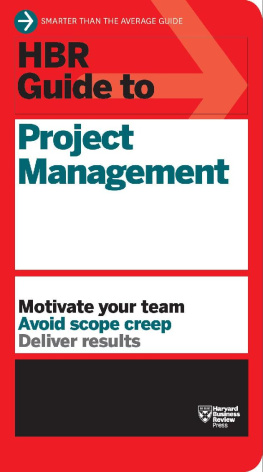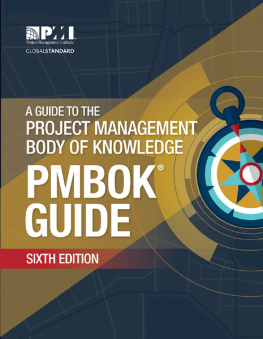HBR Guide to
Project
Management
Harvard Business Review Guides
Arm yourself with the advice you need to succeed on the job, from the most trusted brand in business. Packed with how-to essentials from leading experts, the HBR Guides provide smart answers to your most pressing work challenges.
The titles include:
HBR Guide to Better Business Writing
HBR Guide to Finance Basics for Managers
HBR Guide to Getting the Mentoring You Need
HBR Guide to Getting the Right Job
HBR Guide to Getting the Right Work Done
HBR Guide to Giving Effective Feedback
HBR Guide to Making Every Meeting Matter
HBR Guide to Managing Stress
HBR Guide to Managing Up and Across
HBR Guide to Persuasive Presentations
HBR Guide to Project Management
HBR Guide to
Project
Management
HARVARD BUSINESS REVIEW PRESS
Boston, Massachusetts
Copyright 2012 Harvard Business School Publishing Corporation
All rights reserved
Printed in the United States of America
10 9 8 7 6 5 4 3 2 1
No part of this publication may be reproduced, stored in or introduced into a retrieval system, or transmitted, in any form, or by any means (electronic, mechanical, photocopying, recording, or otherwise), without the prior permission of the publisher. Requests for permission should be directed to , or mailed to Permissions, Harvard Business School Publishing, 60 Harvard Way, Boston, Massachusetts 02163.
Library of Congress Cataloging-in-Publication Data
HBRs guide to project management.
p. cm.
ISBN 978-1-4221-8729-6 (alk. paper)
1. Project management. I. Harvard business review. II. Title:
Guide to project management.
HD69.P75H394 2013
658.4'04dc23
2012026957
eBook development by eBook Architects
What Youll Learn
Youve been asked to lead a project. You appreciate the vote of confidence, but are you panicking because you havent a clue where to begin? Do you worry that stakeholders will tug you in a million directions, making it impossible to set clear goals, let alone deliver the goods on time and on budget? How will you know when to stick to your original plan and when to be flexible? And how will you keep all your team members excited about this projectwhen they have so many other pressures on them?
This guide will give you the confidence and tools you need to manage projects effectively.
Youll get better at:
- Choosing the right team and keeping it humming
- Avoiding scope creep
- Zeroing in on critical tasks and mapping out a logical sequence
- Making heads or tails of Gantt and PERT charts
- Getting disruptive team members on board
- Keeping stakeholders in the loop
- Gauging your projects success
- Deciding when to cut bait
- Capturingand usinglessons learned
Contents
Whats Involved in planning, build-up, Implementation, and closeoutand how these processes overlap
Whos who in project management
Your marching orders
You cant eliminate uncertainty in the early stages of a complex projectbut you can manage it.
BY LOREN GARY
Learn from your project while its still alive and well.
BY GARY KLEIN
Set strict limits on scope, but be flexible when major opportunities arise.
BY LOREN GARY
Three steps for staying on track
BY RON ASHKENAS
Tips for getting your teams calendarsand yoursunder control
BY MELISSA RAFFONI
Put the horse before the cart.
When does speed trump quality?
BY TOM CROSS
Set your project up for success with a well-planned launch.
Mutual accountability leads to astonishing results.
BY JON R. KATZENBACH AND DOUGLAS K. SMITH
Run your meetings well, and infuse your project with energy and direction.
What to do when your usual decision tools cease to be useful in the face of uncertainty
The risks that come with big projectsand how to manage them
BY NADIM F. MATTA AND RONALD N. ASHKENAS
Dont be afraid to revise your plan.
BY RAY SHEEN
Make sure people stay on task, pull their weight, work together, and meet quality standards.
What to do when people disagree on goals, how to achieve them, or both
BY CLAYTON M. CHRISTENSEN, MATT MARX, AND HOWARD H. STEVENSON
How to avoid chasing after sunk costs
BY JIMMY GUTERMAN
Gauge your success before wrapping things up.
BY RAY SHEEN
Four steps to an effective after-action review
BY RAY SHEEN
Overview
Chapter 1
The Four Phases of Project Management
Whether youre in charge of developing a website, designing a car, moving a department to a new facility, updating an information system, or just about any other project (large or small), youll go through the same four phases: planning, build-up, implementation, and closeout. Even though the phases have distinct qualities, they overlap. For example, youll typically begin planning with a ballpark budget figure and an estimated completion date. Once youre in the build-up and implementation phases, youll define and begin to execute the details of the project plan. That will give you new information, so youll revise your budget and end datein other words, do more planningaccording to your clearer understanding of the big picture.
Heres a chart that outlines the activities of each phase, plus the skills and tools you may need for doing the work:
| PROJECT PHASES |
| Planning | Build-up | Implementation | Closeout |
| ACTIVITIES |
| Determine the real problem to solve | Assemble your team | Monitor and control process and budget | Evaluate project performance |
| Identify stakeholders | Plan assignments | Report progress | Close the project |
| Define project objectives | Create the schedule | Hold weekly team meetings | Debrief with the team |
| Determine scope, resources, and major tasks | Hold a kickoff meeting | Manage problems | Develop a postevaluation report |
| Prepare for tradeoffs | Develop a budget |
| KEY SKILLS |
| Task analysis | Process analysis | Supervising | Follow-through |
| Planning | Team building | Leading and motivating | Planning |
| Cost-benefit analysis of options | Delegating | Communication | Communication |
| Negotiating | Conflict management |
| Recruiting and hiring | Problem solving |
| Communication |
| TOOLS |
Work
Breakdown
Structure | Scheduling tools (CPM, PERT, Gantt) | Post-evaluation report: analysis and lessons learned |
Planning: How to Map Out a Project
When people think of project planning, their minds tend to jump immediately to schedulingbut you wont even get to that part until the build-up phase. Planning is really about defining fundamentals: what problem needs solving, who will be involved, and what will be done.
Determine the real problem to solve
Before you begin, take time to pinpoint what issue the project is actually supposed to fix. Its not always obvious.
Say the CIO at your company has asked you, an IT manager, to develop a new database and data entry system. You may be eager to jump right into the project to tackle problems you have struggled with firsthand. But will that solve the












